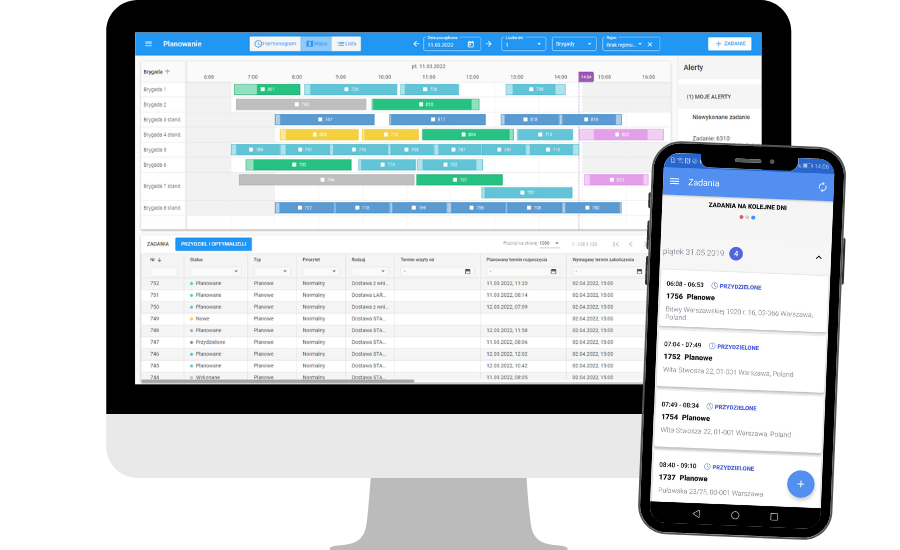
Effective planning and time management are the keys to success. This is true both when planning work schedules for a single employee or a whole team: delivery drivers or fieldwork technicians.
In any case, well-thought-out planning lets you complete more tasks in a shorter time and with less workload. When creating schedules, you must consider some basic factors: the number of tasks, deadlines, the time needed to complete tasks, and required resources (e.g. skills, equipment, tools).
Planning work for one person might be quite easy but it gets complicated when you have to manage dozens or even hundreds of employees. It’s especially hard if these are fieldwork technicians so this is a well-known challenge for companies hiring drivers and technical crews. So how can you effectively plan fieldwork?

What will you learn from this article?
- How can you plan fieldwork?
- What do you need to keep in mind while planning fieldwork?
- What are available tools for scheduling?
- Why is it worth considering automated planning?
- When and why should you consider FSM solutions?
Planning work step by step
What is work planning all about?
Planning any work is a challenge related to organizing a specific number of tasks according to particular criteria. When creating a schedule, you need to consider 3 basic factors that influence the order of task completion:
Deadline for completing each task, e.g. deadline for fixing an outage determined in the customer agreement. Often it specifies a date but also a range of hours for completing the task, e.g. time set for delivering products to a store.
Time needed to complete tasks. Depending on the task type and its difficulty level, it may take less or more time so it’s good to make an estimation.
Resources needed to complete tasks. Some tasks require particular skills or special equipment that only some employees may have, e.g. permissions or soil sampling tools.
The fourth factor you cannot forget is the priority of each task. Depending on the task type, the priority may be related to the deadline – the closer the deadline, the higher the task priority. For example, this is the case with courier companies that offer next-day deliveries.
If the deadline isn’t the most important criterium, the priority has to be set additionally. Usually, priority goes to tasks that stand in the way of completion of other tasks. For example, fixing an outage that disrupts network operations. The further task order has to be set according to your own criteria.
Daily, weekly, and long-term schedules. Goals and priorities
You can make short-term plans (for one day) but also for a few days, weeks, and months in advance. In the case of both short-term and long-term planning, the most important part is to clearly define goals and priorities.
Goals are defined to have a precise vision of what needs be done and why. For example, a goal could be to quickly solve the customer’s problem (fix an outage). Based on the main goal you can determine which tasks will get you closer to achieving it, therefore, which tasks are the priority.
Task locations can also help you determine fieldwork priorities. If a technician is working nearby a location of some less urgent task, it’s worth considering completing it while in this area. This may help avoid driving around and save time and gas.

Planning the unexpected and the 60/40 rule
When planning your tasks, you have to prepare to be a little flexible. Even the best schedule won’t be feasible if you don’t include some time for unexpected events, e.g. equipment malfunction, sudden employee absence, or a task taking longer than estimated.

If you schedule 100% of the working time, you can be sure your plan won’t be realized. A good practice is to schedule only a part of the working hours. According to the 60/40 rule, you should schedule tasks for 60% of the time and keep a 40% buffer time for dealing with unexpected events and sudden urgent tasks. You can’t plan the unexpected but you can be sure that unforeseen events will happen from time to time, so it’s worth it to make space for them in your schedule.
Planning work dispersed in the field
Planning tasks is not easy. As we mentioned before, you have to think about many factors, such as: task type, time needed to complete each task, skills and equipment needed to complete each task, deadlines, priorities.
You make plans for many different people and tasks and in all of this, you should also include buffer time for any unforeseen events.
Planning fieldwork makes it all even more complicated. Fieldwork requires a few additional factors.

- Current road and traffic conditions – travel time changes at different times of the day and week. There are rush hours and also changeable weather conditions that impact travel.
- Driving skills and style as well as how familiar the driver is with the route. Journey times vary from one employee to another.
Then there are also unexpected situations and disruptions in the schedule. A road accident is sure to impact the driving and arrival times.
To limit the time needed for reaching the place and the journey’s impact on the whole schedule, you should group tasks by their locations. This way, one person can complete all tasks within one certain area. It saves both time and gas, reducing the carbon footprint.
Planning routes and tasks that take multiple days and stages to complete
Planning some fieldwork requires scheduling tasks that span more than one working day. A good example is transporting products over long distances, e.g. to another country. So other than the distance, driving time, and traffic conditions, you also need to consider driver’s breaks and daily working hours.

Fieldwork planning tools
There are many tools supporting task scheduling. First, there are the simplest ones: task list written on paper, post-its on a physical or a digital Kanban board. Then, there are advanced programs and mobile applications for task management and scheduling. They track task progress and completion times, send reminders about upcoming deadlines, allow you to assign certain people to a task, etc.

A big advantage of applications is that they provide an option for quickly entering changes in tasks. These are immediately updated for all employees who are directly or indirectly engaged in the task completion.
Mobile task and field workforce management applications have an additional advantage. They give any employee outside of the office (e.g. driver, salesman, technician) insights into the most up-to-date schedule. Fieldworkers with a mobile app don’t have to return to the office or contact anyone to learn which tasks are waiting to be completed. This allows you to optimize employee working times – both those working in the field as well as planners, dispatchers, and call center staff.
Automatization of the route and task scheduling
Even if you use many popular methods and tools for planning tasks, you should consider additionally automating this process. It all depends on how much time the planning process takes and what are its effects.
If planning takes minimal time, up to several dozen minutes a day, and plans are realized successfully, the foregoing methods are sufficient.
However, for many people, planning tasks often takes most of the working day. You know this if you are a person whose main job is to create schedules or if you hire someone for this sole purpose. In that case, you should think about using automation and getting support from modern tools for planning tasks.
Field Service Management (FSM) systems, modern tools for planning fieldwork
Planning support
Applications for planning routes and fieldwork are Field Service Management (FSM) systems. They include all factors needed for effective scheduling:
- distance,
- location,
- traffic conditions,
- employee availability,
- equipment availability,
- required skills, priorities,
- deadlines,
- and many others that you can define yourself.
The FSM systems use algorithms that can analyze and calculate data from many different sources several times faster than humans. Thanks to this, in only a few minutes the FSM systems can create optimal schedules taking the parameters mentioned above into account.
Using automated planning tools, you get much more flexibility when facing unexpected changes in your plans. All you need is to enter a new parameter, and the plan will be automatically updated and optimized according to the new factors.
It’s particularly convenient when you need to consider a high-priority unplanned event, such as an outage, or in case of a sudden absence of an employee.
The algorithm also handles a situation when a task is completed faster than planned. Technicians or couriers have access to an up-to-date task list so they can take care of other work in the area. This greatly improves fieldwork efficiency.
Support for task monitoring
Effective planning is crucial for the fieldwork efficiency but to ensure that the used methods are adequate, you need to monitor progress and verify plan completion. It’s necessary to know how many planned tasks actually got completed.
In this situation, you can also use many different tools, from basic charts on paper or in Excel, to complex applications and systems.
Advanced planning and Field Service Management systems allow you to monitor task progress in real time, and therefore control this process and promptly react to any unforeseen events. These systems also generate different kinds of reports that give you insights into the fieldwork.
Modern solution for a well-known problem
Planning problems are not the challenge of modern times, as they were around centuries ago. What changed nowadays are the customer expectations towards service quality and completion time. Everyone wants to do as much as possible in the shortest time while keeping work quality and at the same time, everyone expects rapid services.
The answer to this challenge are Field Service Management (FSM) systems. They support planning and managing fieldwork. Thanks to complex algorithms, they can analyze large amounts of data from different sources and consider many changing factors while scheduling optimal plans.

Moreover, despite the changing conditions, the algorithms analyze data and determine routes within a few minutes. No person would be able to complete such a process, especially in a short time. The FSM system algorithms enable you to plan and complete hundreds of tasks every day and provide services such as 24h delivery. Thanks to the FSM systems, the time that used to be needed for planning can be dedicated to completing tasks.
How to improve fieldwork planning in your company?
Would you like to learn more about planning fieldwork using Field Service Management tools? Message us – through implementing FSM at companies from different industries (such as transport or retail) we know what solution can support your organization.
